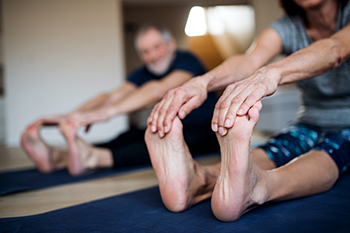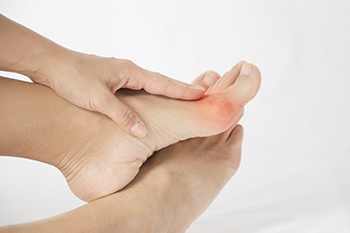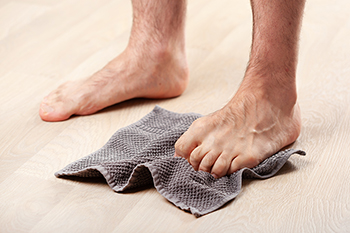
December 2023
How Foot Stretches are Beneficial to Your Health

Exercising the feet and ankles regularly can ward off pain and strengthen these areas, enhancing flexibility in the process. Simple routines like stretching the big toe, spreading the toes, extending the Achilles tendon, and walking in sand can be especially helpful. These exercises ensure that the foot muscles are strong and supportive, contributing to an increased range of motion which is vital for long-term activity and mobility. These types of exercises are straightforward and can be easily integrated into daily routines without the need for specialized equipment. Whether at home or as part of a gym workout, they can become a regular aspect of anyone's fitness regimen, aiding in the maintenance of foot health and overall well-being. If you are interested in learning more about stretching the feet and specific exercises you can do, it is suggested that you make an appointment with a podiatrist who can provide the information you are seeking.
Stretching the feet is a great way to prevent injuries. If you have any concerns with your feet consult with Dr. Randy Garr from Bigfoot Podiatry. Our doctor will assess your condition and provide you with quality foot and ankle treatment.
Stretching the Feet
Being the backbone of the body, the feet carry your entire weight and can easily become overexerted, causing cramps and pain. As with any body part, stretching your feet can serve many benefits. From increasing flexibility to even providing some pain relief, be sure to give your feet a stretch from time to time. This is especially important for athletes or anyone performing aerobic exercises, but anyone experiencing foot pain or is on their feet constantly should also engage in this practice.
Great ways to stretch your feet:
- Crossing one leg over the others and carefully pull your toes back. Do 10-20 repetitions and repeat the process for each foot
- Face a wall with your arms out and hands flat against the wall. Step back with one foot and keep it flat on the floor while moving the other leg forward. Lean towards the wall until you feel a stretch. Hold for 30 seconds and perform 10 repetitions for each foot
- Be sure not to overextend or push your limbs too hard or you could risk pulling or straining your muscle
Individuals who tend to their feet by regular stretching every day should be able to minimize foot pain and prevent new problems from arising.
If you have any questions, please feel free to contact our office located in Provo, UT . We offer the newest diagnostic and treatment technologies for all your foot care needs.
Pain Management for Bunions in Runners

Bunions are bony protrusions that form at the base of the big toe due to prolonged stress on the metatarsophalangeal joint. Detecting them is relatively straightforward through visual inspection, often supplemented by X-rays to assess their severity. For runners, bunions can pose significant challenges, exacerbated by poorly fitting running shoes. Many running shoes, characterized by tapered toe boxes and raised heels, can contribute to bunion development over time. Treatment options range from the simple act of changing shoes and employing pain management techniques, such as medication, to using toe spacers and performing bunion massages. If conservative approaches fall short, surgical intervention may be an option, although it is not always a permanent fix. If you are a runner and have a bunion that is causing you pain, it is suggested that you make an appointment with a podiatrist to discuss pain management techniques that might help you.
If you are suffering from bunions, contact Dr. Randy Garr of Bigfoot Podiatry. Our doctor can provide the care you need to keep you pain-free and on your feet.
What Is a Bunion?
A bunion is formed of swollen tissue or an enlargement of boney growth, usually located at the base joint of the toe that connects to the foot. The swelling occurs due to the bones in the big toe shifting inward, which impacts the other toes of the foot. This causes the area around the base of the big toe to become inflamed and painful.
Why Do Bunions Form?
Genetics – Susceptibility to bunions are often hereditary
Stress on the feet – Poorly fitted and uncomfortable footwear that places stress on feet, such as heels, can worsen existing bunions
How Are Bunions Diagnosed?
Doctors often perform two tests – blood tests and x-rays – when trying to diagnose bunions, especially in the early stages of development. Blood tests help determine if the foot pain is being caused by something else, such as arthritis, while x-rays provide a clear picture of your bone structure to your doctor.
How Are Bunions Treated?
- Refrain from wearing heels or similar shoes that cause discomfort
- Select wider shoes that can provide more comfort and reduce pain
- Anti-inflammatory and pain management drugs
- Orthotics or foot inserts
- Surgery
If you have any questions, please feel free to contact our office located in Provo, UT . We offer the newest diagnostic and treatment technologies for all your foot care needs.
Treatment Options for Claw Toe

Claw toe, a foot deformity characterized by a claw-like appearance of the toes, demands prompt attention to alleviate discomfort and prevent worsening. Non-surgical interventions are often the initial line of defense, focusing on enhancing toe flexibility and optimizing foot mechanics. Taping or splinting to maintain toes in a more natural position, can reduce the progression of a claw toe. Gentle exercises also promote joint mobility and encourage toes to assume a healthier alignment. Activities like picking up small items with your toes can be beneficial. In severe cases, surgical options become a consideration. Joint fusion or tendon and bone operations may be recommended to address the root cause and provide lasting relief. Early intervention significantly improves the prognosis for individuals grappling with claw toe deformity. It is suggested that you schedule an appointment with a podiatrist who can determine the most appropriate treatment plan tailored to managing claw toes. Early intervention significantly improves the prognosis for individuals with claw toe deformity.
Toe pain can disrupt your daily activities. If you have any concerns, contact Dr. Randy Garr of Bigfoot Podiatry. Our doctor can provide the care you need to keep you pain-free and on your feet.
What Causes Toe Pain?
Most severe toe pain is caused due to a sports injury, trauma from dropping something heavy on the toe, or bumping into something rigid. Other problems can develop over time for various reasons.
Toe pain can be caused by one or more ailments. The most common include:
- Trauma
- Sports injury
- Wearing shoes that are too tight
- Arthritis
- Gout
- Corns and calluses
- Hammertoe
- Bunions
- Blisters
- Ingrown toenails
- Sprains
- Fractures (broken bones)
- Dislocations
When to See a Podiatrist
- Severe pain
- Persistent pain that lasts more than a week
- Signs of infection
- Continued swelling
- Pain that prevents walking
Diagnosis
In many cases the cause of toe pain is obvious, but in others, a podiatrist may want to use more advanced methods to determine the problem. These can range from simple visual inspections and sensation tests to X-rays and MRI scans. Prior medical history, family medical history, and any recent physical traumatic events will all be taken into consideration for a proper diagnosis.
Treatment
Treatments for toe pain and injuries vary and may include shoe inserts, padding, taping, medicines, injections, and in some cases, surgery. If you believe that you have broken a toe, please see a podiatrist as soon as possible.
If you have any questions please feel free to contact our office located in Provo, UT . We offer the newest diagnostic tools and technology to treat your foot and ankle needs.
Children’s Sports Injuries

Concerns exist regarding the impact of a sedentary lifestyle on children, but there are also issues related to sports injuries in children participating in organized sports, which often involve intensive training from a young age. This trend is driven by the belief that early training is essential for future success, leading to a younger demographic in sporting activities such as tennis, swimming, and gymnastics. Specialized training at a young age increases the risk of both acute and overuse injuries, with boys, especially during growth spurts, being more susceptible. Factors like physical attributes and playing conditions play a significant role in these injuries, which can range from ligamentous and meniscal injuries to fractures during peak growth periods. Stress fractures, although rare, are noteworthy in young athletes. The long-term consequences of overuse injuries remain a concern. While accidents are more common outside sports settings, the potential long-term impact of overuse injuries in sports such as gymnastics and soccer is an area of concern. If your child is involved in organized sports, it is suggested to consult a podiatrist to discuss preventive measures and address any foot and ankle issues that may arise from sports participation.
The health of a child’s feet is vital to their overall well-being. If you have any questions regarding foot health, contact Dr. Randy Garr of Bigfoot Podiatry. Our doctor can provide the care you need to keep you pain-free and on your feet.
Tips for Keeping Children's Feet Healthy
- Make sure their shoes fit properly
- Look for any signs of in-toeing or out-toeing
- Check to see if they have Clubfoot (condition that affects your child’s foot and ankle, twisting the heel and toes inward) which is one of the most common nonmajor birth defects.
- Lightly cover your baby’s feet (Tight covers may keep your baby from moving their feet freely, and could prevent normal development)
- Allow your toddler to go shoeless (Shoes can be restricting for a young child’s foot)
- Cut toenails straight across to avoid ingrown toenails
- Keep your child’s foot clean and dry
- Cover cuts and scrapes. Wash any scratches with soap and water and cover them with a bandage until they’ve healed.
If you have any questions, please feel free to contact our office located in Provo, UT . We offer the newest diagnostic and treatment technologies for all your foot care needs.






